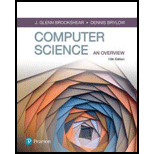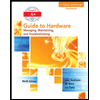
Computer Science: An Overview (13th Edition) (What's New in Computer Science)
13th Edition
ISBN: 9780134875460
Author: Glenn Brookshear, Dennis Brylow
Publisher: PEARSON
expand_more
expand_more
format_list_bulleted
Concept explainers
Question
Chapter 3.1, Problem 3QE
Program Plan Intro
Computer system:
- A computer system is a combination of various input and output devices such as, motherboard, hard drive, rams, CPU, etc which enables the system to perform various operations.
- The basic objective of computer system is to enable their users to perform multiple tasks at the same time, which can be done by using motherboard.
- In the computer system, the user can decide what function to perform on the system for the specific period. Basically, the computer system is also known as general-purpose programmable system.
- A computer system installs and stores the
operating system in order to make a system work.
Example: A user is working on PC to perform some specific task and at the same time he wants to open some other file or document, so the motherboard of a computer system assists the user to perform other task at the same time.
Embedded system:
- This system also performs the same operations as computer systems does, but the main difference is that it performs only one or some set of operations for the specific period of time.
- In other words, the embedded system is dedicated to single purpose or a small set of purposes.
Examples: An ATM machine, air condition, refrigerator, home appliances and many electronic devices.
An embedded system uses chip to install the operating system within the system in order to make a system work.
Expert Solution & Answer
Want to see the full answer?
Check out a sample textbook solution
Students have asked these similar questions
You will write a program that allows the user to keep track of college locations and details about each location. To begin you will create a College python class that keeps track of the csollege's unique id number, name, address, phone number, maximum students, and average tuition cost.
Once you have built the College class, you will write a program that stores College objects in a dictionary while using the College's unique id number as the key.
The program should display a menu in this order that lets the user:
1) Add a new College
2) Look up a College
4) Delete an existing College
5) Change an existing College's name, address, phone number, maximum guests, and average tuition cost.
6) Exit the program
Show all the work
Construct a frequency polygon density estimate for the sample in Question 1, using bin width determined by Sturges’ Rule.
Chapter 3 Solutions
Computer Science: An Overview (13th Edition) (What's New in Computer Science)
Ch. 3.1 - Identify examples of queues. In each case,...Ch. 3.1 - Which of the following activities require...Ch. 3.1 - Prob. 3QECh. 3.1 - Prob. 4QECh. 3.2 - Prob. 1QECh. 3.2 - What is the difference between application...Ch. 3.2 - Prob. 3QECh. 3.2 - Prob. 4QECh. 3.3 - Summarize the difference between a program and a...Ch. 3.3 - Summarize the steps performed by the CPU when an...
Ch. 3.3 - Prob. 3QECh. 3.3 - If each time slice in a multiprogramming system is...Ch. 3.3 - Prob. 5QECh. 3.4 - Prob. 1QECh. 3.4 - Suppose a two-lane road converges to one lane to...Ch. 3.4 - Prob. 3QECh. 3.4 - Prob. 4QECh. 3.5 - Prob. 1QECh. 3.5 - Prob. 2QECh. 3.5 - If a process in a multiprogramming system could...Ch. 3 - List four activities of a typical operating...Ch. 3 - Summarize the distinction between batch processing...Ch. 3 - Prob. 3CRPCh. 3 - Prob. 4CRPCh. 3 - What is a multitasking operating system?Ch. 3 - Prob. 6CRPCh. 3 - On the basis of a computer system with which you...Ch. 3 - a. What is the role of the user interface of an...Ch. 3 - What directory structure is described by the path...Ch. 3 - Define the term process as it is used in the...Ch. 3 - Prob. 11CRPCh. 3 - What is the difference between a process that is...Ch. 3 - What is the difference between virtual memory and...Ch. 3 - Suppose a computer contained 512MB (MiB) of main...Ch. 3 - What complications could arise in a...Ch. 3 - What is the distinction between application...Ch. 3 - Prob. 17CRPCh. 3 - Summarize the booting process.Ch. 3 - Why is the booting process necessary?Ch. 3 - If you have a PC, record the sequence activities...Ch. 3 - Suppose a multiprogramming operating system...Ch. 3 - Prob. 22CRPCh. 3 - Prob. 23CRPCh. 3 - Prob. 24CRPCh. 3 - Prob. 25CRPCh. 3 - Would greater throughput be achieved by a system...Ch. 3 - Prob. 27CRPCh. 3 - What information is contained in the state of a...Ch. 3 - Identify a situation in a multiprogramming system...Ch. 3 - List in chronological order the major events that...Ch. 3 - Prob. 31CRPCh. 3 - Prob. 32CRPCh. 3 - Explain an important use for the test-and-set...Ch. 3 - Prob. 34CRPCh. 3 - Prob. 35CRPCh. 3 - Prob. 36CRPCh. 3 - Prob. 37CRPCh. 3 - Each of two robot arms is programmed to lift...Ch. 3 - Prob. 39CRPCh. 3 - Prob. 40CRPCh. 3 - Prob. 41CRPCh. 3 - Prob. 42CRPCh. 3 - Prob. 43CRPCh. 3 - Prob. 44CRPCh. 3 - Prob. 45CRPCh. 3 - Prob. 46CRPCh. 3 - Prob. 47CRPCh. 3 - Prob. 48CRPCh. 3 - Prob. 49CRPCh. 3 - Prob. 50CRPCh. 3 - Prob. 51CRPCh. 3 - Prob. 52CRPCh. 3 - How is the window manager related to the operating...Ch. 3 - Prob. 54CRPCh. 3 - Prob. 55CRPCh. 3 - Suppose you are using a multiuser operating system...Ch. 3 - Prob. 2SICh. 3 - Prob. 3SICh. 3 - Prob. 4SICh. 3 - Prob. 5SI
Knowledge Booster
Learn more about
Need a deep-dive on the concept behind this application? Look no further. Learn more about this topic, computer-science and related others by exploring similar questions and additional content below.Similar questions
- [5 marks] Give a recursive definition for the language anb2n where n = 1, 2, 3, ... over the alphabet Ó={a, b}. 2) [12 marks] Consider the following languages over the alphabet ={a ,b}, (i) The language of all words that begin and end an a (ii) The language where every a in a word is immediately followed by at least one b. (a) Express each as a Regular Expression (b) Draw an FA for each language (c) For Language (i), draw a TG using at most 3 states (d) For Language (ii), construct a CFG.arrow_forwardQuestion 1 Generate a random sample of standard lognormal data (rlnorm()) for sample size n = 100. Construct histogram estimates of density for this sample using Sturges’ Rule, Scott’s Normal Reference Rule, and the FD Rule. Question 2 Construct a frequency polygon density estimate for the sample in Question 1, using bin width determined by Sturges’ Rule.arrow_forwardGenerate a random sample of standard lognormal data (rlnorm()) for sample size n = 100. Construct histogram estimates of density for this sample using Sturges’ Rule, Scott’s Normal Reference Rule, and the FD Rule.arrow_forward
- Can I get help with this case please, thank youarrow_forwardI need help to solve the following, thank youarrow_forwardreminder it an exercice not a grading work GETTING STARTED Open the file SC_EX19_EOM2-1_FirstLastNamexlsx, available for download from the SAM website. Save the file as SC_EX19_EOM2-1_FirstLastNamexlsx by changing the “1” to a “2”. If you do not see the .xlsx file extension in the Save As dialog box, do not type it. The program will add the file extension for you automatically. With the file SC_EX19_EOM2-1_FirstLastNamexlsx still open, ensure that your first and last name is displayed in cell B6 of the Documentation sheet. If cell B6 does not display your name, delete the file and download a new copy from the SAM website. Brad Kauffman is the senior director of projects for Rivera Engineering in Miami, Florida. The company performs engineering projects for public utilities and energy companies. Brad has started to create an Excel workbook to track estimated and actual hours and billing amounts for each project. He asks you to format the workbook to make the…arrow_forward
arrow_back_ios
SEE MORE QUESTIONS
arrow_forward_ios
Recommended textbooks for you
 Principles of Information Systems (MindTap Course...Computer ScienceISBN:9781285867168Author:Ralph Stair, George ReynoldsPublisher:Cengage Learning
Principles of Information Systems (MindTap Course...Computer ScienceISBN:9781285867168Author:Ralph Stair, George ReynoldsPublisher:Cengage Learning Systems ArchitectureComputer ScienceISBN:9781305080195Author:Stephen D. BurdPublisher:Cengage Learning
Systems ArchitectureComputer ScienceISBN:9781305080195Author:Stephen D. BurdPublisher:Cengage Learning Principles of Information Systems (MindTap Course...Computer ScienceISBN:9781305971776Author:Ralph Stair, George ReynoldsPublisher:Cengage Learning
Principles of Information Systems (MindTap Course...Computer ScienceISBN:9781305971776Author:Ralph Stair, George ReynoldsPublisher:Cengage Learning Fundamentals of Information SystemsComputer ScienceISBN:9781305082168Author:Ralph Stair, George ReynoldsPublisher:Cengage Learning
Fundamentals of Information SystemsComputer ScienceISBN:9781305082168Author:Ralph Stair, George ReynoldsPublisher:Cengage Learning A+ Guide to Hardware (Standalone Book) (MindTap C...Computer ScienceISBN:9781305266452Author:Jean AndrewsPublisher:Cengage Learning
A+ Guide to Hardware (Standalone Book) (MindTap C...Computer ScienceISBN:9781305266452Author:Jean AndrewsPublisher:Cengage Learning

Principles of Information Systems (MindTap Course...
Computer Science
ISBN:9781285867168
Author:Ralph Stair, George Reynolds
Publisher:Cengage Learning

Systems Architecture
Computer Science
ISBN:9781305080195
Author:Stephen D. Burd
Publisher:Cengage Learning

Principles of Information Systems (MindTap Course...
Computer Science
ISBN:9781305971776
Author:Ralph Stair, George Reynolds
Publisher:Cengage Learning

Fundamentals of Information Systems
Computer Science
ISBN:9781305082168
Author:Ralph Stair, George Reynolds
Publisher:Cengage Learning

A+ Guide to Hardware (Standalone Book) (MindTap C...
Computer Science
ISBN:9781305266452
Author:Jean Andrews
Publisher:Cengage Learning
